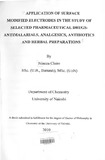| dc.description.abstract | This research was focused on the analysis of selected human drugs and herbal medicines using surface modified Iderivatized electrodes, where the working electrode surface was modified using the chemical substrate of interest. In the study, the following drugs with antimalarial properties were analyzed: quinine, 'Sul&doxine+ Pyrimethamine, 2-sulfanilamido- 3-methoxypyrazine+Pyrimethamine, halofantrine !hydrochloride, and lumefantrine+artemether, which are the most commonly used in the management of malaria in Africa. Other drugs were amoxil (an antibiotic) and paracetamol (an 'aoalgesic).
Analysis-was also carried out on cinchona tree extract and an herbal antimalarial, malbet was also done. The 'electrochemical technique used is cyclic voltammetry. The potential of the electrode was Varied with the potential window ranging from -O.4V to a selected upper limit. The scan rate was ,variable but mostly 20m V lsec. The mechanistic pathways of the oxidation/reduction of the different drugs studied have been proposed and analysis on the effect of pH on the oxidation tial conducted. Jbe results show that sulphuric acid electrolyte media was more suitable for the electrochemical 'aoalysis of the pharmaceutical products studied than hydrochloric acid.
The pH dependence studies conducted suggested that the branded pharmaceutical products quinine, fansidar, halfan and coartem redox processes were IW lIe unlike in the case of amoxil 'redox process, which was 2W /Ie, Studies were also conducted to establish the effect of host matrix on the redox activity of the pharmaceutical products. The host matrices studied included in addition to the bare carbon graphite electrode; bentonite, polyaniline, polythiophene, and the drug itself. In general, the eIectrochemicaI responses were improved significantly in the case of bentonite as compared to r !he other host matrices.
Interactions of the phannaceuticaI preparations with other substances were also studied. This included acetylsalicylic acid, nicotinic acid, ferrous fumerate, folic acid, vitamin C, milk, tea, glycerine, hydrocortisone, paracetamol, methionine, arginine, tyrosine and leucine. Some compounds, like glycerine, milk and tea suppressed the redox activity of the drugs studied while . others like aminoacids enhanced the redox activity of the drugs studied.
The role of different metal ions on the redox properties of the pharmaceutical products studied whereby in certain cases there was enhancement in the redox response while in others there was total suppression of the redox activity. The metal ions studied. included C02+, Zn2+, Cult, and Sn2+ adsorbed on the bentonite modified carbon graphite working electrode. Herbal preparations were also analyzed using surface modified electrode technique and it was Observed that redox active groups were easily detected despite the fact that herbal preparations made up of a cocktail of natural products. | en_US |

